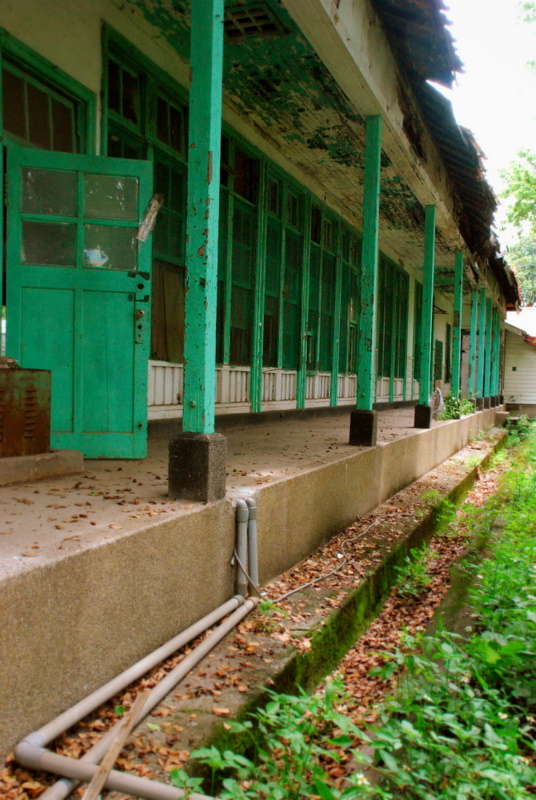TELDAP Collections
| Venturing into the Ruins – Taipei Military Sanatorium, Beitou Branch |
|
A close-up of the Taipei Military Sanatorium, Beitou Branch. Have you ever noticed those abandoned spaces in the hidden corners of a city? Crumbling away, overgrown with weeds, and surrounded by “no entry” barricade tape, they look discouraging enough. However, they were once alive with human activity, and traces of their former glory still remain.
Such spaces are not uncommon. The most well-known example is the Huashan 1914 Creative Park located on the corner of Jinshan North Road and Civic Boulevard in Taipei, which once served as the “Taiwan Wine Workshop , Monopoly Bureau of Taiwan Governor General’s Office” and the “Taipei First Winery, Taiwan Tobacco and Wine Monopoly Bureau” However, not every abandoned place has had the good fortune Huashan has enjoyed. In most cases, the spaces have fallen into disuse and remain derelict because of unclear property rights and lack of funding. Over time, all sorts of strange stories about these “ruins” begin to circulate, resulting in so-called urban legends. It is only natural that the mystique surrounding these legends should draw curiosity seekers to these secret places.
In the picture below is a wooden building steeped in history. It is the remains of the Taipei Military Sanatorium, Beitou Branch, which is located to the south of the Beitou Armed Forces Hospital. The story of the building began during the Japanese colonial period. As soon as the Japanese took over Taiwan, they conducted a wide range of surveys to examine the conditions of Taiwan. When the medical director Hidaeki Fujita was on an inspection visit to Beitou, he noticed the area’s special geological features and suggested that a hospital with hot spring facilities be built there. This was how Beitou’s abundant geothermal resources came to be discovered.
The warm spring water containing blue sulfur is of therapeutic value for treating skin diseases and gout. For the Japanese soldiers who were away from home and craved hot springs, the water not only warmed their bodies but also soothed their exhausted minds. During the Russo-Japanese War, a significant number of wounded soldiers were cured in this hospital. In 1966, after the end of Japanese rule in Taiwan, the Keelung 821 Armed Forces Hospital, which had a department of psychiatry, was moved to the current site of the Taipei Military Sanatorium, Beitou Branch. After years of mergers and reform, the Keelung 821 Armed Forces Hospital became the Beitou Armed Forces Hospital, and the wooden building officially became a city-designated historic building in 1999.
 Wooden verandahs were built to suit Taiwan’s hot and humid climate
The Taipei Military Sanatorium, Beitou Branch is a classic example of Japanese-style wooden houses, with rain shields and verandahs to suit Taiwan’s hot and humid climate. The Taiwanese flavor is also reflected in the use of green clay, a material commonly found in Taiwan.
This Japanese-style wooden house is the only well-preserved Japanese-era building that remains today. Over time, other buildings have been demolished to make room for modern hospital facilities. Today, the building and its premises remain a restricted area for army personnel only. Although it was declared to be a city-designated historic building from as early as 1998, it has been left to its sad fate until today and remains just as run-down as before.
“The Beitou Armed Forces Hospital proposed a historic building conservation plan on September 29, 2009. The restoration design and conservation work was expected to be completed in stages between 2010 and 2011 so that the building could be restored to its former glory in the shortest time possible.” This is the response made by the Taipei City Department of Cultural Affairs in Issue 23, Volume 79 of the Taipei City Council Gazette; nevertheless, the site still remains forlorn today.
Although Taiwan is just a small island, there are numerous abandoned public and private properties such as this one. This derelict building is rarely patrolled and is in imminent danger of collapse, so people are strongly advised not to set foot in it. That being said, however, supernatural tales about this abandoned house spun by locals have added to an atmosphere of romantic fantasy, which may interest those who chance to stray into the area.
References:
Hong, Dejun. (2002). The Local History of Beitou: Hot Springs. Taipei City: Peitou Culture Foundation.
|













